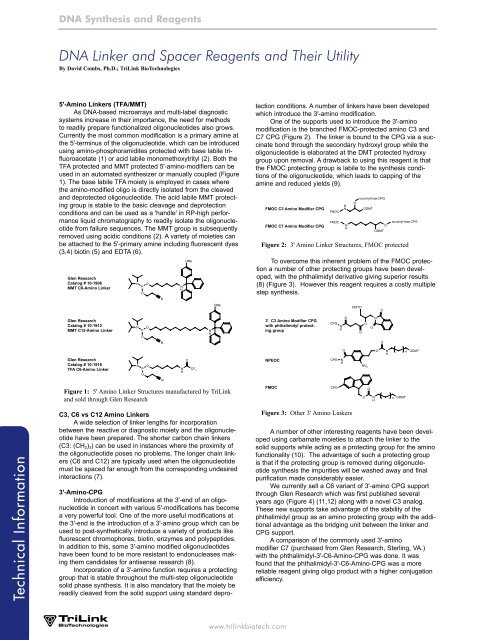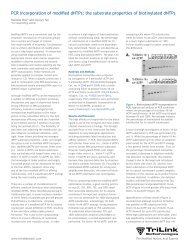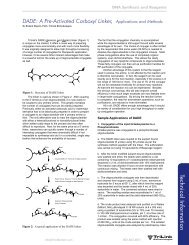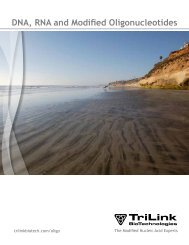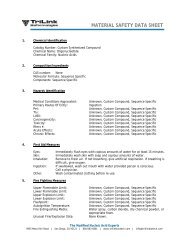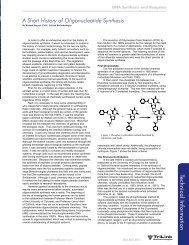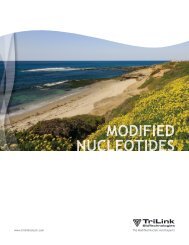DNA Linker and Spacer Reagents and Their Utility - TriLink ...
DNA Linker and Spacer Reagents and Their Utility - TriLink ...
DNA Linker and Spacer Reagents and Their Utility - TriLink ...
You also want an ePaper? Increase the reach of your titles
YUMPU automatically turns print PDFs into web optimized ePapers that Google loves.
Technical Information<br />
<strong>DNA</strong> Synthesis <strong>and</strong> <strong>Reagents</strong><br />
<strong>DNA</strong> <strong>Linker</strong> <strong>and</strong> <strong>Spacer</strong> <strong>Reagents</strong> <strong>and</strong> <strong>Their</strong> <strong>Utility</strong><br />
By David Combs, Ph.D.; <strong>TriLink</strong> BioTechnologies<br />
5'-Amino <strong>Linker</strong>s (TFA/MMT)<br />
As <strong>DNA</strong>-based microarrays <strong>and</strong> multi-label diagnostic<br />
systems increase in their importance, the need for methods<br />
to readily prepare functionalized oligonucleotides also grows.<br />
Currently the most common modification is a primary amine at<br />
the 5'-terminus of the oligonucleotide, which can be introduced<br />
using amino-phosphoramidites protected with base labile trifluoroacetate<br />
(1) or acid labile monomethoxytrityl (2). Both the<br />
TFA protected <strong>and</strong> MMT protected 5'-amino-modifiers can be<br />
used in an automated synthesizer or manually coupled (Figure<br />
1). The base labile TFA moiety is employed in cases where<br />
the amino-modified oligo is directly isolated from the cleaved<br />
<strong>and</strong> deprotected oligonucleotide. The acid labile MMT protecting<br />
group is stable to the basic cleavage <strong>and</strong> deprotection<br />
conditions <strong>and</strong> can be used as a 'h<strong>and</strong>le' in RP-high performance<br />
liquid chromatography to readily isolate the oligonucleotide<br />
from failure sequences. The MMT group is subsequently<br />
removed using acidic conditions (2). A variety of moieties can<br />
be attached to the 5'-primary amine including fluorescent dyes<br />
(3,4) biotin (5) <strong>and</strong> EDTA (6).<br />
Glen Research<br />
Catalog # 10-1906<br />
MMT C6-Amino <strong>Linker</strong><br />
Glen Research<br />
Catalog # 10-1912<br />
MMT C12-Amino <strong>Linker</strong><br />
Glen Research<br />
Catalog # 10-1916<br />
TFA C6-Amino <strong>Linker</strong><br />
N O<br />
P<br />
O<br />
N O<br />
P<br />
O<br />
N O<br />
P<br />
O<br />
Figure 1: 5' Amino <strong>Linker</strong> Structures manufactured by <strong>TriLink</strong><br />
<strong>and</strong> sold through Glen Research<br />
C3, C6 vs C12 Amino <strong>Linker</strong>s<br />
A wide selection of linker lengths for incorporation<br />
between the reactive or diagnostic moiety <strong>and</strong> the oligonucleotide<br />
have been prepared. The shorter carbon chain linkers<br />
(C3: (CH2)3) can be used in instances where the proximity of<br />
the oligonucleotide poses no problems. The longer chain linkers<br />
(C6 <strong>and</strong> C12) are typically used when the oligonucleotide<br />
must be spaced far enough from the corresponding undesired<br />
interactions (7).<br />
3'-Amino-CPG<br />
Introduction of modifications at the 3'-end of an oligonucleotide<br />
in concert with various 5'-modifications has become<br />
a very powerful tool. One of the more useful modifications at<br />
the 3'-end is the introduction of a 3'-amino group which can be<br />
used to post-synthetically introduce a variety of products like<br />
fluorescent chromophores, biotin, enzymes <strong>and</strong> polypeptides.<br />
In addition to this, some 3'-amino modified oligonucleotides<br />
have been found to be more resistant to endonucleases making<br />
them c<strong>and</strong>idates for antisense research (8).<br />
Incorporation of a 3'-amino function requires a protecting<br />
group that is stable throughout the multi-step oligonucleotide<br />
solid phase synthesis. It is also m<strong>and</strong>atory that the moiety be<br />
readily cleaved from the solid support using st<strong>and</strong>ard depro-<br />
N<br />
N<br />
N<br />
N<br />
H<br />
N<br />
H<br />
OMe<br />
O<br />
CF3<br />
N<br />
H<br />
OMe<br />
www.trilinkbiotech.com<br />
tection conditions. A number of linkers have been developed<br />
which introduce the 3'-amino modification.<br />
One of the supports used to introduce the 3'-amino<br />
modification is the branched FMOC-protected amino C3 <strong>and</strong><br />
C7 CPG (Figure 2). The linker is bound to the CPG via a succinate<br />
bond through the secondary hydroxyl group while the<br />
oligonucleotide is elaborated at the DMT protected hydroxy<br />
group upon removal. A drawback to using this reagent is that<br />
the FMOC protecting group is labile to the synthesis conditions<br />
of the oligonucleotide, which leads to capping of the<br />
amine <strong>and</strong> reduced yields (9).<br />
FMOC C3 Amino Modifier CPG<br />
FMOC C7 Amino Modifier CPG<br />
FMOC<br />
FMOC<br />
H<br />
N<br />
N<br />
H<br />
succinyl-lcaa-CPG<br />
O<br />
ODMT<br />
succinyl-lcaa-CPG<br />
O<br />
ODMT<br />
Figure 2: 3' Amino <strong>Linker</strong> Structures, FMOC protected<br />
To overcome this inherent problem of the FMOC protection<br />
a number of other protecting groups have been developed,<br />
with the phthalimidyl derivative giving superior results<br />
(8) (Figure 3). However this reagent requires a costly multiple<br />
step synthesis.<br />
3' C3 Amino Modifier CPG<br />
with phthalimidyl protecting<br />
group<br />
NPEOC<br />
FMOC<br />
CPG<br />
CPG<br />
CPG<br />
N<br />
H<br />
O<br />
N<br />
H<br />
Figure 3: Other 3' Amino <strong>Linker</strong>s<br />
O<br />
DMTO<br />
N<br />
O<br />
O<br />
O<br />
A number of other interesting reagents have been developed<br />
using carbamate moieties to attach the linker to the<br />
solid supports while acting as a protecting group for the amino<br />
functionality (10). The advantage of such a protecting group<br />
is that if the protecting group is removed during oligonucleotide<br />
synthesis the impurities will be washed away <strong>and</strong> final<br />
purification made considerably easier.<br />
We currently sell a C6 variant of 3'-amino CPG support<br />
through Glen Research which was first published several<br />
years ago (Figure 4) (11,12) along with a novel C3 analog.<br />
These new supports take advantage of the stability of the<br />
phthalimidyl group as an amino protecting group with the additional<br />
advantage as the bridging unit between the linker <strong>and</strong><br />
CPG support.<br />
A comparison of the commonly used 3'-amino<br />
modifier C7 (purchased from Glen Research, Sterling, VA.)<br />
with the phthalimidyl-3'-C6-Amino-CPG was done. It was<br />
found that the phthalimidyl-3'-C6-Amino-CPG was a more<br />
reliable reagent giving oligo product with a higher conjugation<br />
efficiency.<br />
NO 2<br />
O<br />
O N H<br />
O<br />
O<br />
O N H<br />
n ODMT<br />
n ODMT
Glen Research<br />
Catalog # 20-2956<br />
Pth C6-Amino <strong>Linker</strong> CPG<br />
Glen Research<br />
Catalog # 20-2954<br />
Pth C3-Amino <strong>Linker</strong> CPG<br />
CPG<br />
CPG<br />
H<br />
N<br />
O<br />
H<br />
N<br />
ODMT<br />
5'-Aldehyde Modification<br />
Another approach for introducing reactive functionality<br />
at the 5'-end that can be further modified post synthetically<br />
is the 5'-aldehylde. In contrast to the 5'-amino <strong>and</strong> 5'-thiol<br />
modifications, which are nucleophilic substitutions, the aldehyde<br />
modifier is an electrophilic substitution. The aldehyde<br />
moiety can be reacted with a variety of substituted hydrozinos<br />
<strong>and</strong> semicarbazides to form stable hyrozones <strong>and</strong> semicarbazides,<br />
respectively (13). The 5'-Aldehydes can also react with<br />
amines to form Schiff's base, but the Schiff's base must be<br />
reduced to form a stable linkage.<br />
Two phosphoramidites that incorporate an aldehyde moiety<br />
on the 5'–terminus are available. The amidites introduce<br />
the aldehyde via a benzaldehyde functional group but vary<br />
in the linker length (C6 vs C2). Both aldehyde modifiers are<br />
incorporated using st<strong>and</strong>ard solid phase synthesis methodologies.<br />
However, the 5'-aldehyde modifier C2 is protected <strong>and</strong><br />
the aldehyde must be freed using detritylation conditions with<br />
80% acetic acid or 2% aqueous trifluoroacetic acid after purification.<br />
O<br />
5'-<strong>Spacer</strong>s<br />
A number of different spacer phosphoramidites are available<br />
(Figure 5). These spacer amidites differ in the number of<br />
atoms <strong>and</strong> are typically used to bridge sections of oligonucleotides.<br />
In addition spacers can be used in conjunction with<br />
3' <strong>and</strong> 5'-amino-modifiers <strong>and</strong>/or additional spacers to place<br />
tags at greater distances from the oligonucleotide <strong>and</strong> reduces<br />
interaction between the oligonucleotide <strong>and</strong> the fluorescent<br />
dye (14). They can also increase hybridization to a support<br />
bound oligonucleotide by reducing steric interaction between<br />
support <strong>and</strong> bound oligo (15). The C3 spacer can be used to<br />
mimic the three carbon spacing between the 3'- <strong>and</strong> 5'-hydroxyls<br />
of the oligonucleotide (16) or replace a base within a<br />
sequence when the base is unknown. The d<strong>Spacer</strong> can be<br />
used to mimic abasic sites within an oligonucleotide <strong>and</strong> is<br />
known to undergo β-elimination reactions <strong>and</strong> lead to single<br />
O<br />
O<br />
N<br />
O<br />
O<br />
N ODMT<br />
Figure 4: 3' Amino <strong>Linker</strong> Structures manufactured by <strong>TriLink</strong><br />
<strong>and</strong> sold through Glen Research<br />
Glen Research<br />
Catalog # 10-1909<br />
<strong>Spacer</strong> 9<br />
Glen Research<br />
Catalog # 10-1913<br />
C3/Propyl <strong>Linker</strong> Amidite<br />
Glen Research<br />
Catalog # 10-1914<br />
d<strong>Spacer</strong><br />
Figure 5: <strong>Spacer</strong>s<br />
DMTO<br />
DMTO<br />
N<br />
O<br />
DMTO<br />
N<br />
O<br />
O P O<br />
O<br />
O O<br />
P<br />
N<br />
N<br />
O P O<br />
N<br />
N<br />
<strong>DNA</strong> Synthesis <strong>and</strong> <strong>Reagents</strong><br />
str<strong>and</strong> scission of <strong>DNA</strong> (17,18).<br />
5'-Thiol-Modifiers<br />
As the number of thiol specific dyes continue to increase<br />
so does the interest in 3'- <strong>and</strong> 5'-thiol modified oligonucleotides.<br />
Like the 3'- <strong>and</strong> 5'- amino modifiers the thiol modification<br />
can be used to introduce biotin (19). In addition to this<br />
powerful tool, thiols can be conjugated with a variety of fluorescent<br />
probes (20) via reactions of the thiol with iodoacetate<br />
<strong>and</strong> maleimide derivatives of the dye to form thioether linkages,<br />
enzymes such as horseradish peroxidase, <strong>and</strong> peptides<br />
via a disulfide linkage (21), <strong>and</strong> bound to metal surfaces (22).<br />
Thiol modification at the 5'-end of the oligonucleotide<br />
is typically done using the 5'-thiol-modifier C6 or the 5'-thiol<br />
modifier C6 S-S (Figure 6). Like the MMT protected amino<br />
linker the trityl protecting group on the 5'-thiol-modifier C6 is<br />
usually kept on after cleavage of the oligonucleotide to aid in<br />
purification. However, because the trityl group is not as acid<br />
labile, unlike MMT or DMT, it must be removed by oxidation<br />
with silver nitrate. Although successfully used, oxidative detritylation<br />
can be a problem.<br />
An alternative to this reagent is the 5'-thiol-modifier C6<br />
S-S. As with other reagents the trityl protecting group can be<br />
kept to aid in purification of the oligonucleotide. The thiol is<br />
then freed by treatment with dithiothreitol (DTT).<br />
Glen Research<br />
Catalog # 10-1926<br />
5' Thiol Modifier C6<br />
Glen Research<br />
Catalog # 10-1936<br />
5' Thiol Modifier C6 S-S<br />
References<br />
1. Greene, T. W.: Wuts, G. M. Protective Groups in Organic Synthesis<br />
3rd Ed. John Wiley & Sons, Inc. New York<br />
2. Connolly, B. A. (1987) Nucleic Acids Research, 15, 3131.<br />
3. Connolly, B. A.; Rider, P. (1985) Nucleic Acids Research, 13, 4485.<br />
4. Zuckerman, R.; Corey, D.; Shultz, P. (1987) Nucleic Acids Research,<br />
15, 5305.<br />
5. Kempe, T. et al. (1985) Nucleic Acids Research. 13, 45.<br />
6. Dreyer, G. B.; Dervan, P. B. (1985) Proc. Natl. Acad. Sci. USA, 82,<br />
968.<br />
7. Hogrefe, R. I.; Mackie, H.; Powell, M. L. (1988) Amer. Biotechnologies<br />
News Ed. 6, 47.<br />
8. Vu, H.; Joyce, N.; Rieger, M.; Walker, D.; Goldknopt, I.; Hill, T. S.;<br />
Jayaraman, K.; Mulvey, D. (1995) Bioconjugate Chem. 6, 599.<br />
9. Trilink catalog, p. 94.<br />
10. Aviño, A.; Garcia, R. G.; Albericio, F.; Mann, M.; Wilm, M.; Nebauer,<br />
G.; Eritja, R. (1996) Bioorganic & Medicinal Chemistry 4, 1649.<br />
11. Petrie, C. R.; Reed, M. W., Adam, D. A.; Meyer, R. B. Jr. (1992)<br />
Bioconjugate Chem., 3, 85.<br />
12. Reed, M. W.; Meyer, R. B. Jr., Petrie, C. R.; Tobone, J. C. U.S. Patent<br />
5,419,966 (1995).<br />
13. Shchepino, M. S.; Korshun, V. A. (2001) Nucleosides, Nucleotides &<br />
Nucleic Acids 20, 369.<br />
14. Trawick, B. N.; Osiek, T. A.; Bashkin, J. K. (2001) Bioconjugate Chem.<br />
12, 900.<br />
15. Takeshita, M.; Chang, C. N.; Johnson, F.; Will, S.; Grollman, A.P.<br />
(1987) J. Biol. Chem. 262, 10171.<br />
16. Kalnik, M.W.; Chang, C.N.; Grollman, A. P.; Patel, D.J. (1988),<br />
Biochemistry 27, 924.<br />
17. Sproat, B. S.; Beijer, B. S.; Rider, P.; Neuner, P. (1987) Nucleic Acids<br />
Research, 15, 4837.<br />
18. Hermanson, G. T. Bioconjugate Techniques, Acedemic Press, San<br />
Diego.<br />
19. Antopolsky, M.; Azhayev, A. (2001) Nucleosides, Nucleotides &<br />
Nucleic Acids 20, 539.<br />
20. Doronina, S. O.; Guzaev, A. P.; Monoharan, M. (2001) Nucleosides,<br />
Nucleotides & Nucleic Acids 20, 1007.<br />
info@trilinkbiotech.com 800-863-6801<br />
N P O<br />
O<br />
N P O<br />
Figure 6: 5' Thiol <strong>Linker</strong>s<br />
O<br />
N<br />
N<br />
S<br />
S S<br />
O<br />
OMe<br />
OMe<br />
Technical Information


